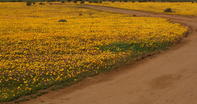Primary Ground Cover
The erratic distribution of the flowers is caused by several factors, including soil composition, the wind-blown dispersal of seeds, ambient temperatures, rainfall patterns, topography and other geographical inscrutables. So, during flower season, you have to drive around to bit to find the best sites, either in terms of volume, diversity or rarity.

This quest can become all-consuming and every tourist seems to have only one question on their lips, ‘where’s a good place to see the flowers?’. It’s kinda like looking for lions in the Kruger Park, except the flowers don’t eat Japanese tourists.
The one thing you should be aware of is that the flowers tend to grow on disturbed ground where the established vegetation has been removed or reduced.
This usually occurs on farm lands used for grazing animals or on disused fields that have been previously ploughed but not sown, sometimes called ‘oldfields’. This is because the flowers are part of what is known as primary ground cover, the first plant species to start growing on freshly turned land.
If the land is left alone too long, it will be colonised by bushes and shrubs (secondary ground cover) and flowers will not have the space to grow once secondary plants have become established. So, the best places for flower spotting are on fallow farmland, grazing ground and untended roadside verges.
As an example, consider the miraculously rich flower site at Matjiesfontein Farm, near Nieuwoudtville, which follows a very simple method to encourage this process. The secret, they say, is as follows: the sheep are let into the fields at the end of September to graze on the dried up flowers and ‘mis’, (do their business).
The animals are taken out in March to give the plants a chance to rest and then, in August/September, the flowers come out again. The Skilpad wildflower garden at the Namaqua National Park uses a similar method, but a good ploughing will also work.
By David Fleminger